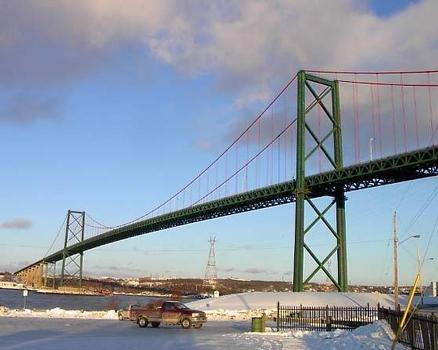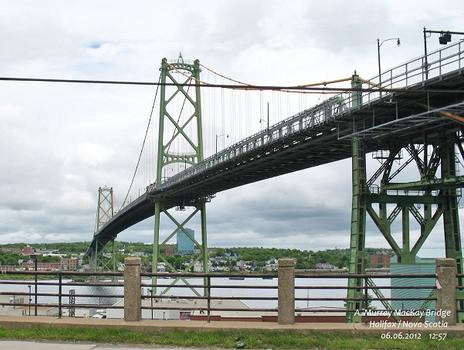General Information
Project Type
| Structure: |
Three-span suspension bridge |
|---|---|
| Function / usage: |
Motorway bridge / freeway bridge |
| Material: |
Steel bridge |
| Material: |
Structurae Plus/Pro - Subscribe Now! Structurae Plus/Pro - Subscribe Now! |
| Secondary structure(s): |
Structurae Plus/Pro - Subscribe Now! |
Location
| Location: |
Halifax, Nova Scotia, Canada |
|---|---|
| Coordinates: | 44° 40' 38.36" N 63° 36' 42.74" W |
Technical Information
Dimensions
| main span | 426 m | |
| total length | 1 200 m | |
| suspended length | 739.9 m | |
| number of lanes | 4 | |
| vertical navigation clearance | 46.9 m | |
| pylons | height | 96 m |
Materials
| cables |
steel wire
|
|---|---|
| piers |
reinforced concrete
|
| pylons |
steel
|
| deck truss |
steel
|
Excerpt from Wikipedia
The A. Murray MacKay Bridge, known locally as "the new bridge", is a suspension bridge linking the Halifax Peninsula with Dartmouth, Nova Scotia, and opened on July 10, 1970. It is one of two suspension bridges crossing Halifax Harbour, the other, Angus L. Macdonald Bridge having been completed in 1955. The bridge carries on average 52,000 vehicle crossings per day, and is part of Nova Scotia Highway 111.
As of April 1, 2011, the toll charge to cross for regular passenger vehicles is $1.00 cash, or 80¢ with the Macpass electronic toll system (60¢ tokens were once used but are no longer accepted as of May 1, 2008). Larger vehicles have higher tolls proportional to the number of axles. The Halifax-Dartmouth Bridge Commission is exploring the idea of moving entirely to electronic tolls to avoid handling tokens or cash. The A. Murray MacKay Bridge is the only harbour bridge which permits semi-trailers and large trucks. Pedestrians and bicycles are not permitted on the A. Murray MacKay Bridge; they may use dedicated lanes on the Angus L. Macdonald Bridge instead.
Design
The bridge measures 1,200 m (3,900 ft) with the total of all suspended spans being 739.9 m (2,427 ft) in length, carrying four traffic lanes with posted speed limits of 70 km/h (43 mph). It was designed with a maximum road gradient of 4 percent. It is notable as having been the first bridge built in North America using an orthotropic steel deck, which yielded a completed structure having half the overall mass of the Macdonald Bridge nearby. Engineering of the bridge also employed the pioneering use of wind tunnel testing which considered the impact of winds on the structure both during construction and when complete.
Financing
In 1970, a decision was made to finance the construction of the bridge with low-interest loans denominated in foreign currencies. That decision saved money in the short term and allowed the tolls to be kept low. However, the subsequent decline in the value of the Canadian dollar against the German Mark and the Swiss franc wiped out the interest cost advantage, then added massively to annual debt servicing costs. At its peak, the Commission's debt amounted to nearly $125,000,000, nearly triple the total cost of construction for both harbour bridges of about $42,000,000.
Impact on development
The building of the MacKay Bridge, along with Highway 111, initiated a development boom in Dartmouth which eclipsed that created by the Macdonald Bridge during the 1950s and 1960s. The Burnside Business Park, the Mic Mac Mall shopping centre, and several residential developments in the Albro Lake neighbourhood in Dartmouth's north end during the 1970s can be directly attributed to the bridge's construction.
Controversies
Africville
Political controversy preceded construction of the MacKay Bridge when the city of Halifax expropriated residents from the community of Africville near the Halifax abutment. New highway interchanges were built with the northern end of Barrington Street, and an extension of Robie Street and the Bedford Highway (Trunk 2), as well as realignments of Highway 102 and Bayers Road. Some CN railway trackage in the area also had to be realigned.
Renaming
The bridge is named after Alexander Murray MacKay, chairman of the Halifax-Dartmouth Bridge Commission from 1951 to 1971 and past chief executive officer of MT&T. MacKay was instrumental in having both the Angus L. Macdonald Bridge and his namesake structure built during his tenure at the commission.
Following the death of former Nova Scotia premier Robert L. Stanfield in 2003, there was a motion made to rename the MacKay Bridge to honour Stanfield, but the Stanfield family did not want any current structures already named for persons to be changed for Stanfield's sake. In 2007, the Halifax International Airport was renamed Halifax - Robert L. Stanfield International Airport; several new schools and other institutional buildings are also under consideration for Stanfield's name. The appropriateness of a bridge being named after a living Bridge Commission chair during his tenure remains controversial.
Text imported from Wikipedia article "A. Murray MacKay Bridge" and modified on July 23, 2019 according to the CC-BY-SA 4.0 International license.
Participants
Currently there is no information available about persons or companies having participated in this project.
Relevant Web Sites
Relevant Publications
- (2020): Long-Term Movement Behaviour of Bridge Bearings and Expansion Joints from SHM Data. Presented at: IABSE Symposium: Synergy of Culture and Civil Engineering – History and Challenges, Wrocław, Poland, 7-9 October 2020, pp. 1125-1132.
- (2023): Main Cable Inspection and Strength Evaluation of Helicoidal Strand Main Cables Using a Modified NCHRP Evaluation Approach. Presented at: IABSE Symposium: Long Span Bridges, Istanbul, Turkey, 26-28 April 2023, pp. 409-416.
- About this
data sheet - Structure-ID
20006028 - Published on:
06/10/2002 - Last updated on:
29/08/2023






